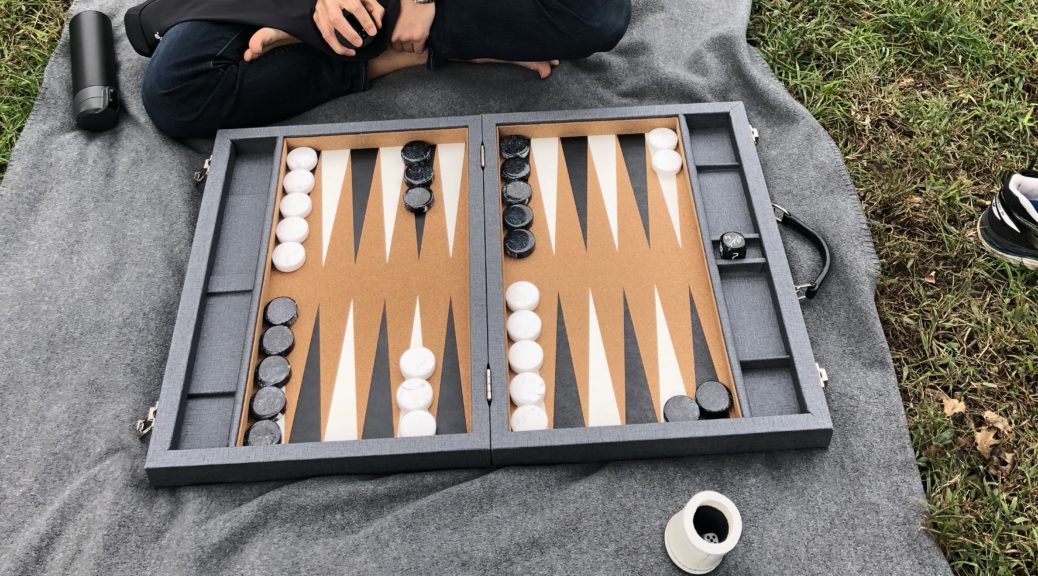Backgammon is a beautiful game.
Obviously, a physical backgammon board can be beautiful. The field of tall triangles with circular checkers lying on top is an attractive geometric pattern. Backgammon’s frequently a high-end game, and fancy boards have features like exquisitely swirled Bakelite checkers, hand-stitched leather fields, alligator skin attaché cases, or other absurdities.
However, consider the beauty of backgammon’s game mechanics. Although backgammon is a simple game — able to be summarized in 160 words (see below) — the gameplay is dynamic, engaging, and potentially heartbreaking. In every facet, the elementary rules generate extraordinary emergent characteristics which, in turn, demand intricate strategical considerations, and that’s a beautiful thing.
Katie introduced me to the game on the day I graduated from medical school (5/30/18). I still remember sitting there in the Club library, dressed to the nines, champagne on the side table, Katie demonstrating how “hit” “blots” go to “the bar.” Even in our first few games, I saw so many of these emergent behaviors manifest themselves: huge swings in tense games where the game boiled down to the very last roll. Backgammon was obviously my favorite type of game (where game complexity arises from the rule set, not player’s whimsies) and yet the rules were super duper simple.
What rules, you might ask!?
A summary of backgammon rules
(Modern) Backgammon is a two-player turn-based game. On a 24-point track, you and your opponent alternate rolling two dice to advance your 15-checker armies forward to get all checkers off the board and home first. The starting position is for each: two on 24 away from home, five 13 away, three 8 away, and five 6 away. Double rolls have twice the value. Maximal usage of rolls are obligatory. Single checkers are vulnerable to being hit back to the beginning, where they must reenter before other moves are taken. Checkers may only start to be removed once all 15 are in the final quartile. You can win two or three points if you get all 15 home before your opponent gets 1 home or escapes the first quartile, respectively. Before each roll, you may “double,” and your opponent must either forfeit the game or accept to play on at twice the value while possessing the sole privilege to “redouble” before you may double again.
All right, so if you haven’t played backgammon before or if you only have a vague mediocre impression of the game from previous experiences (it’s that one game that comes with chess and checkers!), I encourage you to give it another try. I promise you, it’s more fun than you probably remember. And this is why:
Beautiful rules
Initially, it may seem that backgammon is just a race and he who rolls bigger numbers wins, but that sentiment is thwarted instantly by the most salient rule in all of backgammon: solitary blots are vulnerable. This is from where all strategies in backgammon emerge, turning a race into a positional battle when you must constantly balance safety and flexibility. This is why building a wall (priming), leaving a couple checkers to rescue other friends that are hit later (anchoring), or bum-rushing stragglers (blitzing) all become valid strategies.
Backgammon is fundamentally a game of dice. Every single turn has 21 non-overlapping future game spaces, thanks to the dice. The key takeaway is that no matter how much better one player is, no matter how much you plan, there’s always a chance! It keeps backgammon accessible to beginners, unlike the stifling perfect zero-randomness of some games (here’s looking at you, chess…).
Doubles have twice the value. That is, rolling 6 and 6 lets you play four 6s! The difference between ace-deuce (1, 2) and boxcars (6, 6) is an enormous eight-fold: 3 pips versus 24 pips. This makes the little chances in the inherently dice-based game have enormous implications. Even at the very end, in the bear-off, the ability to move four checkers each turn makes even the endgame susceptible to comebacks.
Gammons and backgammons win twice and thrice as many points. If the only two outcomes were to win or lose, runaway games would get boring and encourage suicidal play to regain marginal advantages. However, because it matters whether you lose by a little (1 point) or a lot (2 points) or total annihilation (3 points), it keeps both players playing honestly to scrape up/salvage extra points until the very end.
The doubling cube exists. Backgammon was played with just the dice, board, and checkers for many millennia, but in the 1920s ,some New Yorkers introduced the most difficult aspect of the modern game: the doubling cube. Proper play requires you to precisely valuate the game state on every single turn. Proper play requires emotional discipline: the courage to “take” games when a single roll could virtually guarantee losing 4 points or the humility to “drop” games which slip away after unlucky rolls. And the cube magnifies the effect of all of the above, making quality backgammon difficult to play.
Well, medium-difficult. Backgammon’s complexity pales when compared to chess or go, but that’s what made it appealing to me. I realized I could learn it quickly, so — predictably — I did.
Honestly, I didn’t foresee my subsequent obsession with it although, equally honestly, I’m not surprised given my long streak of obsessions with marginally useful interests. I’ve read books by Magriel, Robertie, and others. I’ve played plenty of practice games on XG Mobile (The Alpha0 of backgammon). I’d be up for entering tournaments at this point. Maybe I’ve already won some. =P

